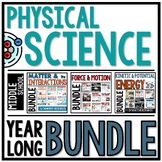Matter and Its Interactions: Chemistry Bundle for Middle School
- Zip
Products in this Bundle (16)
showing 1-5 of 16 products
Bonus
Also included in
- Teaching is hard! Make things easier with this complete year long curriculum that has everything you need to teach a full year of physical science . This year long bundle includes everything you need to teach a middle school level course that meets the NGSS physical science standards for. This bundlPrice $179.20Original Price $256.00Save $76.80
Description
Unleash the power of hands-on learning and ignite a passion for middle school chemistry with this NGSS-aligned bundle about matter and chemical reactions. This engaging set of resources covers a wide range of topics, including the structure and properties of matter, states of matter, mixtures, chemical reactions, conservation of mass, and natural and synthetic resources. Packed with hands-on activities, informative reading passages, and review worksheets, this bundle provides a comprehensive and interactive learning experience for students.
Aligned with the NGSS Physical Science Standards MS-PS 1 - 1 through MS-PS1-6, this bundle meets the needs of diverse learning styles and provides ample opportunities for practice and reinforcement. Students will actively participate in their learning , making observations, conducting experiments, and applying their knowledge to real-world scenarios.
Equip your students with a strong foundation in middle school chemistry. Spark their curiosity and watch their understanding of chemistry come to life!
Please see Preview for details about each included resource
Topics Covered:
- Properties and Structure of Matter
- States of Matter
- Mixtures and Solutions
- Chemical Reactions - Exothermic and Endothermic
- Conservation of Mass (Matter)
- Natural and Synthetic Resources






